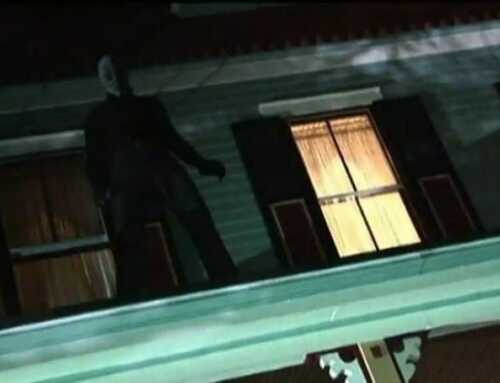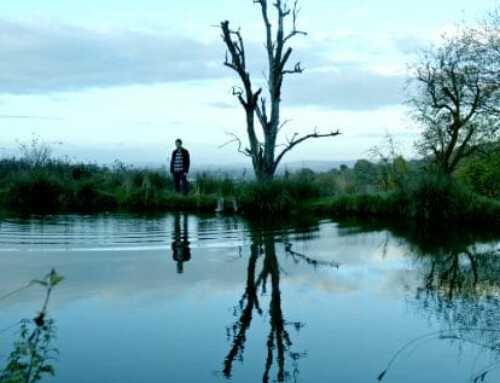Released just six months ago, Ti West’s cleverly layered homage to grindhouse cinema X saved its best twist for last: a post-credit teaser trailer to Pearl, a prequel simultaneously shot in secret during the production of X, and focused on the early days of X’s psychotically libidinous elderly antagonist Pearl. As surprising as the trailer itself was its bold shift in mood and aesthetics, with the immersive 16mm-inspired dust and grime of X giving way to vivid colors, sweeping music, and titles splayed across the screen in a melodramatic cursive font, suggesting something more Douglas Sirk than Tobe Hooper. No doubt those who appreciated West’s clear devotion to the films that inspired X were ready for what promised to be Far From Heaven with a body count – but would Pearl arrive with the thud of an unsuccessful gimmick, or as another revelatory, entertaining, and bloodsoaked trip through cinematic history?
Feeling trapped in her small-town farm existence in 1918, young Pearl spends her days caring for her ailing father while butting heads with her domineering, deeply-devout mother. Constantly fantasizing about the glitz and glamour of the Hollywood life suggested by the movies she watches at her local cinema, Pearl identifies opportunities for escape when she forms a connection with the cinema’s handsome projectionist, then later when she learns that a talent scout is coming to her town. Pearl dedicates herself to making her dreams come true with ferocious intensity, but when she’s met with disappointment, her endearingly sweet naivete – which we learn early-on lies on the thin ice of a burgeoning savergy – gives way to bloodshed.
While weaving a far more straightforward and familiar tale than X, Pearl surprises by arguably being the superior film in West’s 2022 slasher saga. To criticize Pearl for being predictable – and in its predictability, for not being particularly scary – is to miss the point. Part of what works so well about Pearl is that so much of it is predictable. Like X before it, Pearl’s story is wrapped inside a filmmaker’s love letter to the singular styles of the auteur filmmakers whose films have served to inspire him. And like X, it’s also his gift to cinephiles hungry to recognize and point out motifs, shots, visuals, props, and other elements clearly meant to recall films and film eras of the past, while enjoying the experience of seeing how a cinephile auteur employs those elements to tell a compelling story that stands on its own. It’s no accident, for example, that the opening shots of X and Pearl are notably similar, but the subtle difference between the two so effectively serves to set the stage for so much of what is to come thematically and stylistically.
From its first frames and notes there is so much about Pearl that feels intimately familiar, and after West presents a pair of visuals early on that seem to deliberately suggest twisted recalls to The Wizard of Oz, it’s as is the film invites you to identify the film references therein, ultimately elevating Pearl as a work of horror cinema to be enjoyed at various levels simultaneously. In that regard a comparison could be made between X/Pearl and the Kill Bill films – both were released six months apart, both (specifically in the case of Pearl, which was co-written by West and Goth) were creative collaborations between writer-director and star, both will no doubt be endlessly debated as to which of the two parts was the “superior” one, and of course, both tell enthralling stories while brimming with not-so-subtle film references. While Pearl satisfies with its genuinely compelling coming-of-age story of a young homicidal maniac, it also offers a film-geek funhouse of recalls including, to name a few, Carrie, Blue Velvet, Happy Birthday to Me, Fargo, and – once again – The Texas Chainsaw Massacre. Providing the cohesive glue to elevate such an experiment to its own effective narrative film are Eliot Rockett’s strikingly gorgeous cinematography and Tyler Bates and Tim Williams’ award-worthy score, both managing to be as playfully referential as they feel genuinely evocative.
It’s ultimately Mia Goth’s fantastic lead performance, however, that gives this high-wire act its unmistakable soul. Reprising her role as Pearl (for those still not in the know, yes that was Goth under all that make-up as X’s lusty old slayer), Goth manages to establish Pearl as a beguiling and ultimately sympathetic horror villain, a remarkable achievement particularly when considering the fate we’ve already learned awaits those who cross her path decades later. From earlier scenes of sexual awakening to an unexpectedly stunning third-act monologue, Goth infuses Pearl with the sullen-eyed coquettishness of a young Shelley Duvall – all hints of menace only bubble up as she’s pushed closer and closer to a breaking point. With the antecedent of X, and again after an early scene that establishes that all is not well with Pearl’s mental state, it’s a credit to both West’s and Goth’s evident affection for Pearl that one finds themselves hoping that this young killer-to-be’s candy-colored dreams could all come true.
9 OUT OF 10
| Pearl | ||
| RATING: | N/A |
Pearl | Official Trailer HD | A24
|
| Runtime: | 1 Hr. 27 Mins. | |
| Directed By: | ||
| Written By: | ||







